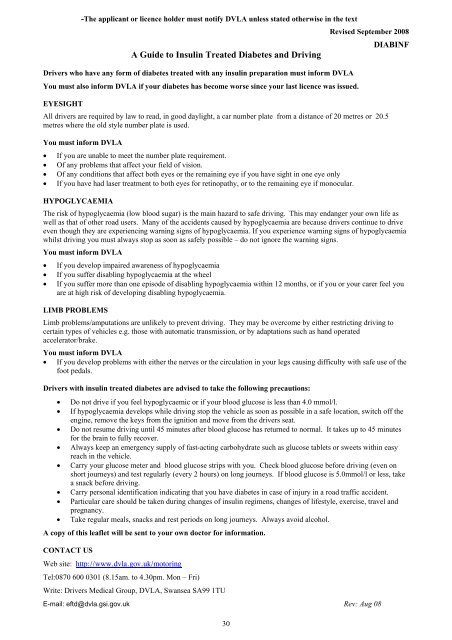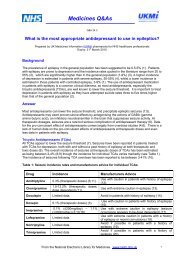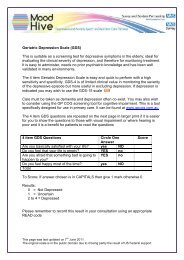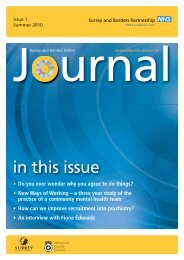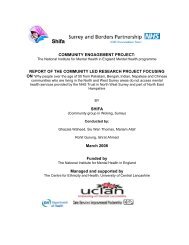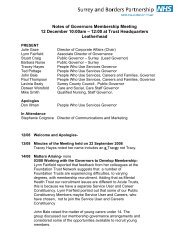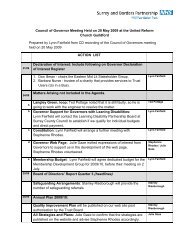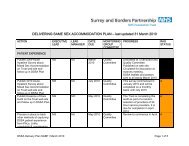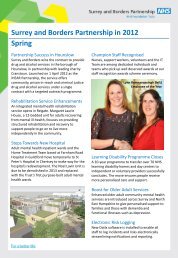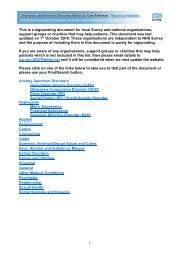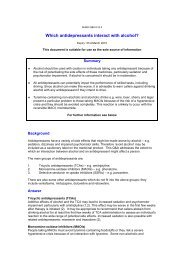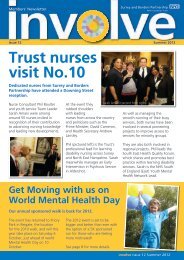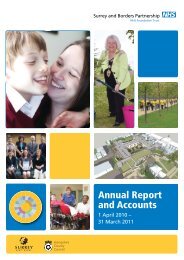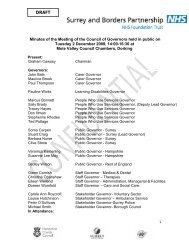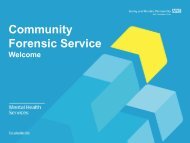DVLA "at a glance" fitness to drive - Heart Rhythm UK
DVLA "at a glance" fitness to drive - Heart Rhythm UK
DVLA "at a glance" fitness to drive - Heart Rhythm UK
You also want an ePaper? Increase the reach of your titles
YUMPU automatically turns print PDFs into web optimized ePapers that Google loves.
-The applicant or licence holder must notify <strong>DVLA</strong> unless st<strong>at</strong>ed otherwise in the text<br />
A Guide <strong>to</strong> Insulin Tre<strong>at</strong>ed Diabetes and Driving<br />
Drivers who have any form of diabetes tre<strong>at</strong>ed with any insulin prepar<strong>at</strong>ion must inform <strong>DVLA</strong><br />
You must also inform <strong>DVLA</strong> if your diabetes has become worse since your last licence was issued.<br />
EYESIGHT<br />
30<br />
Revised September 2008<br />
All <strong>drive</strong>rs are required by law <strong>to</strong> read, in good daylight, a car number pl<strong>at</strong>e from a distance of 20 metres or 20.5<br />
metres where the old style number pl<strong>at</strong>e is used.<br />
You must inform <strong>DVLA</strong><br />
• If you are unable <strong>to</strong> meet the number pl<strong>at</strong>e requirement.<br />
• Of any problems th<strong>at</strong> affect your field of vision.<br />
• Of any conditions th<strong>at</strong> affect both eyes or the remaining eye if you have sight in one eye only<br />
• If you have had laser tre<strong>at</strong>ment <strong>to</strong> both eyes for retinop<strong>at</strong>hy, or <strong>to</strong> the remaining eye if monocular.<br />
HYPOGLYCAEMIA<br />
DIABINF<br />
The risk of hypoglycaemia (low blood sugar) is the main hazard <strong>to</strong> safe driving. This may endanger your own life as<br />
well as th<strong>at</strong> of other road users. Many of the accidents caused by hypoglycaemia are because <strong>drive</strong>rs continue <strong>to</strong> <strong>drive</strong><br />
even though they are experiencing warning signs of hypoglycaemia. If you experience warning signs of hypoglycaemia<br />
whilst driving you must always s<strong>to</strong>p as soon as safely possible – do not ignore the warning signs.<br />
You must inform <strong>DVLA</strong><br />
• If you develop impaired awareness of hypoglycaemia<br />
• If you suffer disabling hypoglycaemia <strong>at</strong> the wheel<br />
• If you suffer more than one episode of disabling hypoglycaemia within 12 months, or if you or your carer feel you<br />
are <strong>at</strong> high risk of developing disabling hypoglycaemia.<br />
LIMB PROBLEMS<br />
Limb problems/amput<strong>at</strong>ions are unlikely <strong>to</strong> prevent driving. They may be overcome by either restricting driving <strong>to</strong><br />
certain types of vehicles e.g. those with au<strong>to</strong>m<strong>at</strong>ic transmission, or by adapt<strong>at</strong>ions such as hand oper<strong>at</strong>ed<br />
acceler<strong>at</strong>or/brake.<br />
You must inform <strong>DVLA</strong><br />
• If you develop problems with either the nerves or the circul<strong>at</strong>ion in your legs causing difficulty with safe use of the<br />
foot pedals.<br />
Drivers with insulin tre<strong>at</strong>ed diabetes are advised <strong>to</strong> take the following precautions:<br />
• Do not <strong>drive</strong> if you feel hypoglycaemic or if your blood glucose is less than 4.0 mmol/l.<br />
• If hypoglycaemia develops while driving s<strong>to</strong>p the vehicle as soon as possible in a safe loc<strong>at</strong>ion, switch off the<br />
engine, remove the keys from the ignition and move from the <strong>drive</strong>rs se<strong>at</strong>.<br />
• Do not resume driving until 45 minutes after blood glucose has returned <strong>to</strong> normal. It takes up <strong>to</strong> 45 minutes<br />
for the brain <strong>to</strong> fully recover.<br />
• Always keep an emergency supply of fast-acting carbohydr<strong>at</strong>e such as glucose tablets or sweets within easy<br />
reach in the vehicle.<br />
• Carry your glucose meter and blood glucose strips with you. Check blood glucose before driving (even on<br />
short journeys) and test regularly (every 2 hours) on long journeys. If blood glucose is 5.0mmol/l or less, take<br />
a snack before driving.<br />
• Carry personal identific<strong>at</strong>ion indic<strong>at</strong>ing th<strong>at</strong> you have diabetes in case of injury in a road traffic accident.<br />
• Particular care should be taken during changes of insulin regimens, changes of lifestyle, exercise, travel and<br />
pregnancy.<br />
• Take regular meals, snacks and rest periods on long journeys. Always avoid alcohol.<br />
A copy of this leaflet will be sent <strong>to</strong> your own doc<strong>to</strong>r for inform<strong>at</strong>ion.<br />
CONTACT US<br />
Web site: http://www.dvla.gov.uk/mo<strong>to</strong>ring<br />
Tel:0870 600 0301 (8.15am. <strong>to</strong> 4.30pm. Mon – Fri)<br />
Write: Drivers Medical Group, <strong>DVLA</strong>, Swansea SA99 1TU<br />
E-mail: eftd@dvla.gsi.gov.uk Rev: Aug 08


